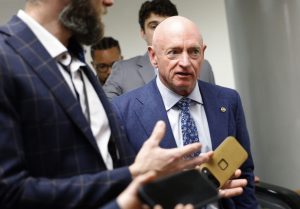Liz Renner is pictured on Nov. 4, 2025, in Sioux Falls, South Dakota. She worked for the U.S. Fish and Wildlife Service until she lost her job as part of the Trump administration’s reduction of the federal workforce. (Photo by Makenzie Huber/South Dakota Searchlight)
When 9-year-old Liz Renner visited the Gavins Point National Fish Hatchery in southeastern South Dakota with her grandfather, she was hooked.
In adulthood, she devoted more than a decade of education and work to understanding the intricacies of fish biology and conservation. Then, in May 2024, she was hired to work at the hatchery as a fish biologist and member of the Pallid Sturgeon Recovery Program, working to save the endangered species of fish.
“But it felt more like a nightmare at the end than a dream come true,” said the 31-year-old, originally from Crooks.
From insiders to ousted
This is the first of four stories about federal government employees or contractors in South Dakota affected by the Trump administration’s reduction of the federal workforce.
Renner was laid off in February under Department of Government Efficiency action, reinstated in March, and then offered and accepted a deferred resignation weeks later because she feared she’d be let go again later on. She was paid her federal wages through the end of September in exchange for her leaving her position.
“I finally felt like I could breathe after I left the hatchery for a second time,” Renner said. “It was a sense of relief that the roller coaster was done for me.”
Renner was one of about 154,000 federal employees who took buyouts — officially known as deferred resignations — offered by the Trump administration earlier this year as a way to reduce the size of the federal workforce. Office of Personnel Management Director Scott Kupor said recently that he expects the total decrease in the federal workforce to reach more than 300,000 eventually.
Of the 45 probationary employees laid off in February in the U.S. Fish and Wildlife Service’s Mountain-Prairie Region, which includes eight states, Renner said she was one of at least 25 who didn’t return, either because they were not reinstated after DOGE cut them or because they accepted a buyout. Probationary employees are recent hires, usually in the first year of their position. Their loss burdened remaining employees with larger workloads and a hectic summer, Renner heard from her former colleagues.
‘My trust in these institutions is forever shaken’
At this point, Renner is grateful she was able to stay in her field and in the Midwest. Many other former federal biologists are not as fortunate, she said.
Renner moved in with her grandmother in Lyons, South Dakota, and splits her time between there and Lincoln, Nebraska, as a post-doctoral fisheries biologist at the University of Nebraska.
Now she researches, teaches and mentors students, and warns them about what they face. Their most promising options, she tells them, are finding a program out of the country, working in private consulting or with nonprofits, or working in liberal states with legislatures that prioritize conservation funding.
Due to federal workforce reductions, Renner said, those recent graduates may be competing for an entry-level or seasonal job against someone with a master’s degree or over 10 years of experience in the field. Other peers have left the fisheries field altogether.
Renner remains passionate about research to conserve, propagate and reintroduce threatened and endangered fish and improve water quality in the state. She plans to stay in the field and look at ways to accomplish her mission outside of the federal government.
“My trust in these institutions is forever shaken,” Renner said, adding that if federal cuts continue, “I don’t know what young person in good conscience could look at what’s happened and say, ‘I want to work for the U.S. Fish and Wildlife Service.’”
When D.C. news affects South Dakota, stay in the know: Sign up for our free newsletter.





